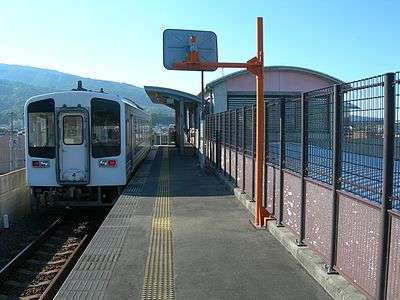Nahari Station
Nahari Station (奈半利駅, Nahari-eki) is a railway station on the Asa Line in Nahari, Aki District, Kōchi Prefecture, Japan. It is operated by the third-sector Tosa Kuroshio Railway with the station number "GN21".[1][2]
Nahari Station 奈半利駅 | |
|---|---|
.jpg) Nahari Station in 2015 | |
| Location | Otsu, Nahari-cho, Aki-gun, Kōchi-ken 781-6402 Japan |
| Coordinates | 33°25′31″N 134°01′06″E |
| Operated by | Tosa Kuroshio Railway |
| Line(s) | ■ Asa Line |
| Distance | 42.7 km from Gomen |
| Platforms | 1 side platform |
| Tracks | 1 |
| Construction | |
| Structure type | Elevated |
| Parking | Available |
| Bicycle facilities | Bike shed, bike rentals |
| Disabled access | Yes - elevator to platform |
| Other information | |
| Status | Staffed ticket window |
| Station code | GN21 |
| Website | Official website |
| History | |
| Opened | 1 July 2002 |
| Traffic | |
| Passengers (FY2011) | 358 daily |
| Location | |
 Nahari Station Location within Japan | |
Lines
The station is served by the Asa Line and is located 42.7 km from the beginning of the line at Gomen.[3] It is the eastern terminus for the Asa Line and all trains, both rapid and local, stop and turn back at the station.[4]
Layout
The station consists of a side platform serving a single elevated track. The station building built into the elevated structure houses a waiting area, a restaurant and a ticket window. Access to the platform is by a flight of steps or an elevator. There is a designated parking area for bicycles under the elevated structure and bike rentals are available from the station. Parking for cars is available at the station forecourt. The station building is also a designated tsunami evacuation area.[2][3][5][6]
 A view of the station platform and tracks.
A view of the station platform and tracks.
Station mascot
Each station on the Asa Line features a cartoon mascot character designed by Takashi Yanase, a local cartoonist from Kōchi Prefecture. The mascot for Nahari Station is a girl in a station master's uniform named Nahariko-chan (なはりこちゃん).[7]
History
The train station was opened on 1 July 2002 by the Tosa Kuroshio Railway as the eastern terminus of its track from Gomen.[8]
Passenger statistics
In fiscal 2011, the station was used by an average of 358 passengers daily.[8]
See also
References
- "Shikoku Railway Route Map" (PDF). JR Shikoku. Retrieved 23 December 2017.
- "奈半利" [Nahari]. hacchi-no-he.net. Retrieved 20 February 2018.
- Kawashima, Ryōzō (2013). 図説: 日本の鉄道 四国・九州ライン 全線・全駅・全配線・第1巻 四国東部エリア [Japan Railways Illustrated. Shikoku and Kyushu. All lines, all stations, all track layouts. Volume 1 Eastern Shikoku] (in Japanese). Kodansha. pp. 50, 86. ISBN 9784062951609.
- "時刻表 ごめん・なはり線" [Timetable Gomen-Nahari Line] (PDF). Tosa Kuroshio Railway. Retrieved 17 February 2018.
- "奈半利" [Nahari]. nacl.sakura.jp. Retrieved 20 February 2018.
- "土佐くろしお鉄道 奈半利駅" [Tosa Kuroshio Railway Nahari Station]. Tosa Kuroshio Railway Official Website. Retrieved 20 February 2018.
- "なはりこちゃん" [Nahariko-chan]. gomen-nahari.com. Retrieved 20 February 2018.
- Terada, Hirokazu (19 January 2013). データブック日本の私鉄 [Databook: Japan's Private Railways] (in Japanese). Japan: Neko Publishing. pp. 173, 303. ISBN 978-4-7770-1336-4.
| Wikimedia Commons has media related to Nahari Station. |